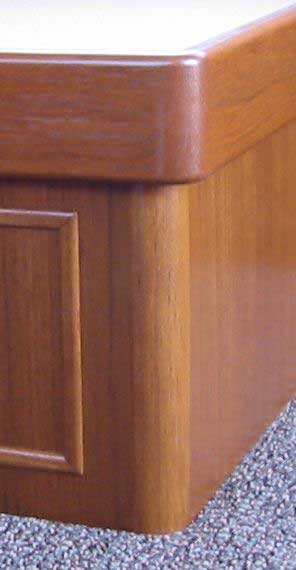Question
How do you process a full radiused top rail for a cabinet door? I process the rail blank to size, cut the tenons on the ends, and attach sacrificial stiles to the tenons with tape. Then I cut the radius and the rail cut with the CNC. I have problems with breakout on the outbound (right) side of the cut. I had hoped backing up the cut with the stile stock would stop that, but it appears that the piece is so small the last 1/2" or so breaks off. Is there another way?
Forum Responses
(Architectural Woodworking Forum)
From contributor D:
Couple of methods I use for the top rail on entry doors:
1- Make pie segments with grain oriented with your radius. Glue these together into a slightly oversized half round (I prefer loose tenon joinery here because you can cut your pie sections close together from a single vertical grain board and, when rejoining them, get easy, continuous circular grain flow that machines well and matches the color of your stiles). Then machine the final dimensions out of the half round stock and join to stiles (I prefer mortise in the rails and vertically oriented blind tenons in the stiles.)
2 - I have some customers who insist on a single piece top rail, horizontally oriented like the rest of the rails. For these I just cope and tenon a huge top rail a bit wider than your radius, say 19" for a 36" roundtop, making sure to thoroughly saturate the copes with glue and get lots of squeeze-out when assembling. After curing you can cut out the radius.
Couple problems with this method, though. The spot where the top rail starts to blend into the stile is a risky cut. Even on a CNC machine, those tiny end grain tips might blow out, or look different on one side than the other. Note this is, even after glued, much easier than using a sacrificial stile machining it alone. Even if they come out perfect, that end grain turns out darker than the adjacent stile when finishing. You also end up with more exposed end grain on the top of the door. It is also not as strong. Furthermore, since you're cutting out the radius after the door's been assembled, you'll be limited to panels held in with stops. The fact is, stops glued and shot in fail way more often than not. The raised moulding or stops buckle and move easily when the panel moves, which is not only unsightly, but there goes the weather-tight integrity of the door. I see these doors everywhere I go, not just at work, but even in places like a doctor's office, a very climate controlled environment.
I have one customer who requires some tricky joinery that is a hybrid of the above two methods - basically making two horizontally oriented top rails with a bridle joint right in the center, allowing you to field panels when assembling. It would be a viable method for your cabinet doors.
It is extremely rare to get blowouts machining in a circle on pie segments, and that alone is the overwhelming reason I prefer it.
I have also done segmented arches like contributor D recommends, cutting out the arch and the end cuts on the CNC (make the end cuts first, a little bit long, then do the arch cuts). Then make a matching MDF sled to cope the ends on the shaper, with back-up blocks behind the cuts.
Special Note: The top rail is comprised of 2 pieces of wood: shoulder-locked and then shoulder-locked to the adjoining stiles. This will prevent separation.
